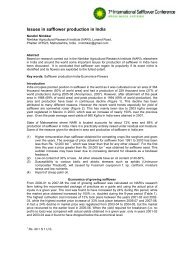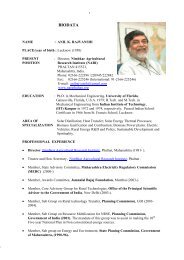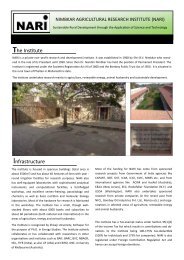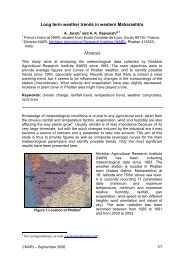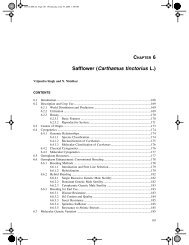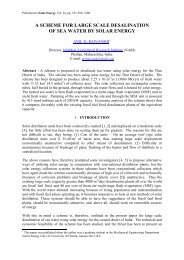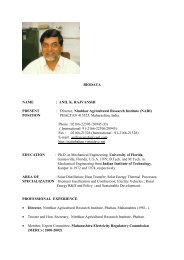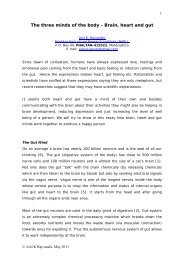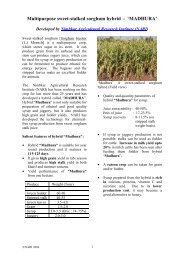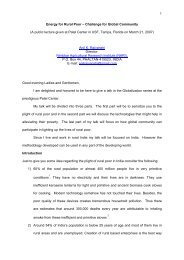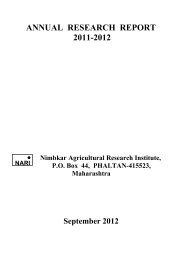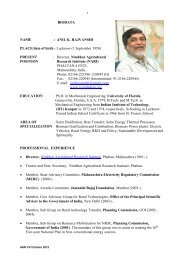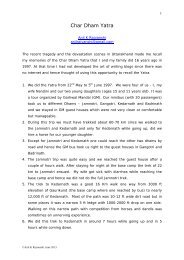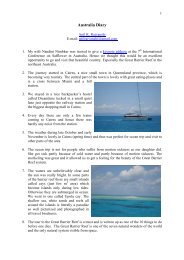You also want an ePaper? Increase the reach of your titles
YUMPU automatically turns print PDFs into web optimized ePapers that Google loves.
4innovations regarding the solar detoxification of distillery effluent. This method has beensuccessfully tested in a pilot plant set up at <strong>NARI</strong> campus to treat 100 l effluent per day.Many distilleries have expressed interest in this technology.Rural power generationAnother example of need-based research was the development of loose biomass gasifier. InPhaltan taluka there are two sugar factories with a lot of farmers growing sugarcane. Aftercutting the sugarcane, farmers burn the dried leaves on ground. There are estimates that Indiaproduces about 800-1200 million tons of agriculture residues every year and most of them areburned in the fields. This is not only a loss of a valuable natural resource, but also leads totremendous air pollution and production of greenhouse gases. Recently it has been shown thatburning of agricultural residues in the subcontinent is the cause of the huge brown cloud overthe area.Dr. <strong>Rajvanshi</strong> has through his writings and speeches brought out the fact that agriculturalresidues can produce almost half of the electric power of India. Besides they will also giveextra income to the farmers. Recently this strategy is being promoted by the Govt. of India. Inorder to produce power on small scale from agricultural residues, Dr. <strong>Rajvanshi</strong> and his teamdeveloped and setup at <strong>NARI</strong> campus a 500 KW th loose sugarcane leaves gasifier for whichthey have received a patent. The gasifier which is totally automatic and is a PLC-basedsystem can be very useful for providing heat for rural businesses. This gasifier set up in 1997was the first such invention anywhere in the world which produced gas from loose leafybiomass material for heating purposes and also produced biochar-an excellent soilconditioner, as a byproduct.The development of a gasifier running on loose agricultural residues led Dr. <strong>Rajvanshi</strong> todevelop a concept of providing electric power to a taluka (equivalent to a county inU.S.A.) from the agricultural residues produced within its geographical boundary. He is theprincipal author of national policy on Energy Self-Sufficient Talukas. This policy wasimplemented by the Ministry of Non-conventional Energy Sources, Government of India. Asa part of this policy all the talukas of the country were surveyed and a biomass map of Indiawas produced for power generation. Also as a part of this policy Government of India,through Indian Renewable Energy Development Agency (IREDA), has provided soft loans tomore than 100 biomass-based power stations (each of 6-10 MW capacity) in the country.This is a prime example of Dr. <strong>Rajvanshi</strong>’s efforts in creating a national program forproducing environmentally sound power from renewable biomass source. He has alsoextended this concept to a village-level micro-utility.Rural transportAs a part of providing sustainable transport system in rural areas where distances are small,Dr. <strong>Rajvanshi</strong> has concentrated his efforts since 1995 on improving the cycle rickshaw sothat the hardships being borne by the rickshaw pullers are reduced.The existing cycle rickshaw has been totally reengineered for the comfort of passengers andrickshaw puller. He and his team have therefore developed three types of rickshaws. In theimproved cycle rickshaw (IMPRA), the length of chain has been reduced; it has back-wheelbraking, three-speed gears and it is lightweight. All these improvements enable the rickshawpuller to take two passengers on a 6-10% slope quite effortlessly without alighting from hisAKRbiodata June 2014



